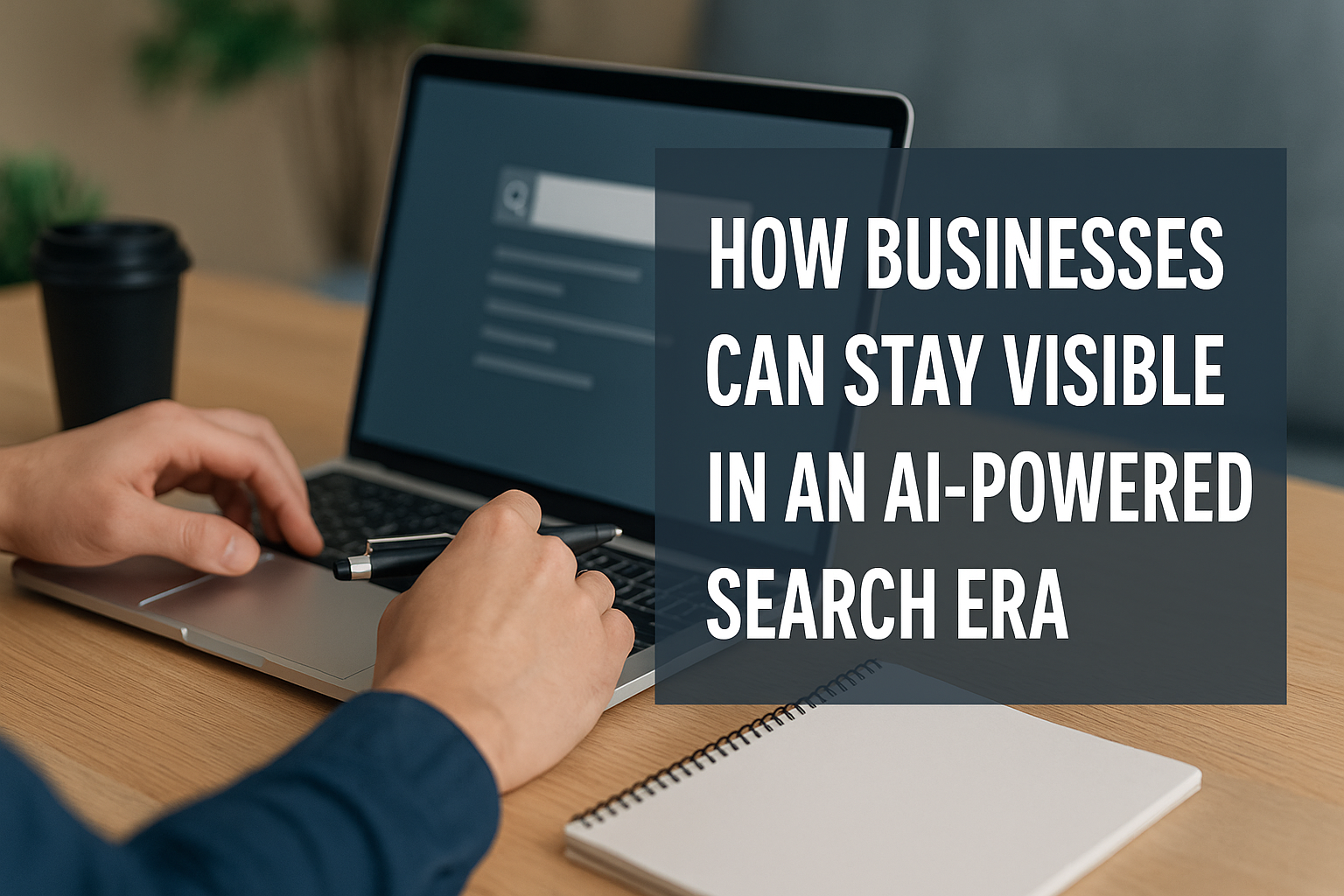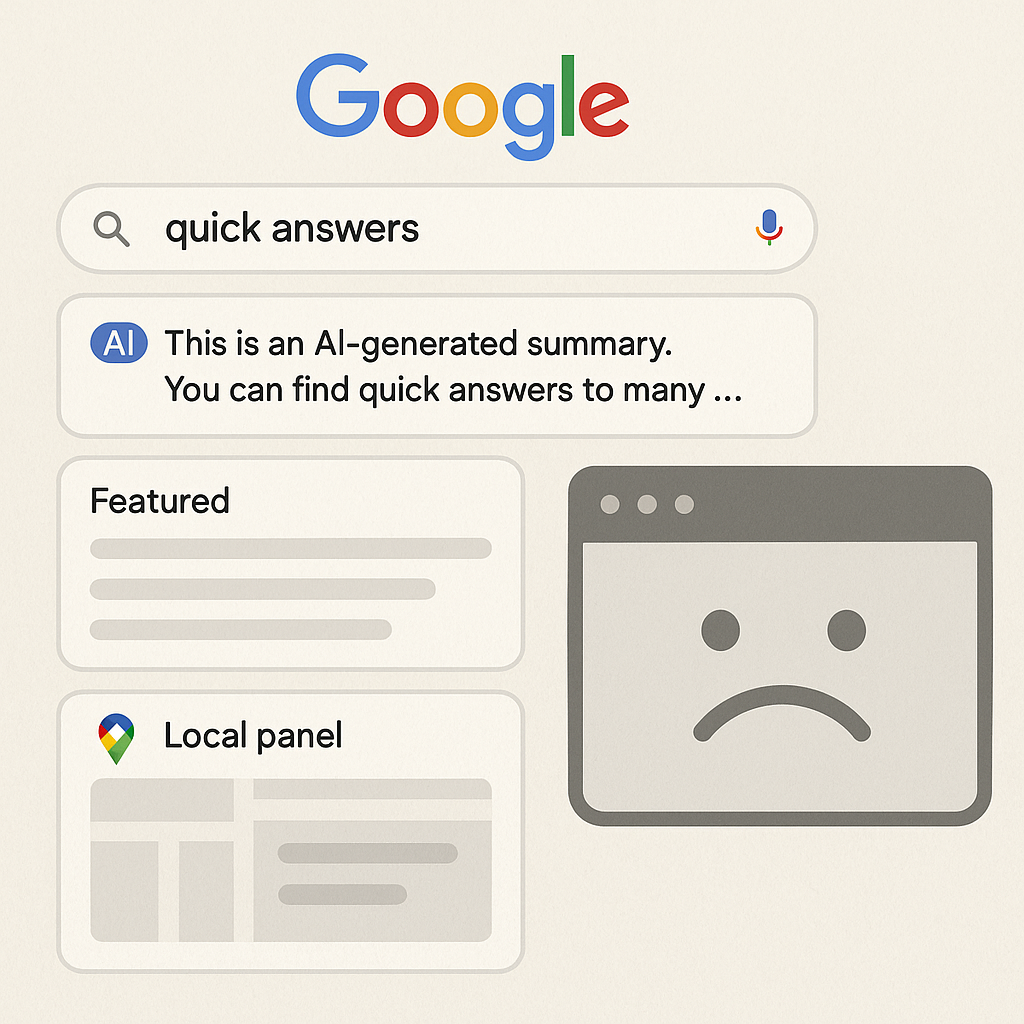
People who look for quick answers on Google often find what they need right at the top of the results page. AI-generated summaries, featured boxes and local panels deliver instant responses, so there is less reason to tap through to a business website. This shift means your site could lose visits, even if interest in your product or service is strong.

At the same time, the role of search engine optimisation has shifted. Rather than aiming solely for page-one rankings, brands must think about how to appear in these summary panels and local profiles. That way, even if a user never clicks through, your business still gains exposure.
Defining Zero-Click Search and Why It Matters?
Zero-click search refers to any scenario where the user’s question is resolved on the results page without requiring the user to load another site. Common formats include:
- AI Overviews that blend snippets into a concise reply.
- Quick-answer boxes that extract a snippet of text (featured snippets).
- Knowledge panels – extracting data from trusted sources.
These features satisfy many queries at a glance. For brands, missing out on those spots means fewer opportunities to guide a prospect to product pages, contact forms, or blogs. Instead of focusing only on classic organic listings, attention must shift to securing a place in these on-page answer zones.
How This Trend Has Evolved?
Google first introduced rich results such as Definitions and Local Packs more than a decade ago, specifically in 2009. Over the years, these have evolved into featured snippets and expanded knowledge graphs. In late 2023, AI Overviews arrived, offering more in-depth, machine-generated summaries.
Search data indicates that the share of zero-click queries is rising steadily, particularly for questions such as “Who’s the Prime Minister of Australia?” or “Metric to imperial conversion.” Many business-related searches now trigger business profiles or quick tables.
This steady rise means your SEO plan must address opportunities beyond organic links. Capturing any of those top-of-page spots that position your brand in front of searchers whether they click or not.
Winning Featured Snippet Exposure
Featured snippets still grab the eye. They sit above all other results in a bordered box, summarising key information. Landing here increases brand visibility, even if fewer people click through to the site.
To optimise for these:
- Start answers with a direct statement or definition in one or two sentences.
- Use lists or numbered steps for processes or comparisons.
- Format headings to match common search queries.
- Add a brief teaser that hints at additional detail on your site.
When users want more depth, they will visit your page. Even without a click, seeing your name next to the answer builds trust.
Leveraging AI-Driven Summaries
AI Overviews aggregate content from multiple sources to provide longer insights. These may include a paragraph of explanation, a brief overview of pros and cons, or a concise bulleted list.
Your best response is to publish thorough, well-organised guides that include:
- Original research or exclusive data.
- Expert commentary or interview excerpts.
- Clearly label sections so Google’s algorithms can pick up headings.
Sites with the strongest authority signals are more likely to be cited in these AI-generated answers. Ensuring your pages are technically sound and fast loading also helps solidify your standing.
Local Searches Without a Click
People seeking services near them often see a Local Pack or Google Business Profile at the top of the search results. That panel shows phone numbers, opening hours, ratings and maps. Visitors record directions or tap to call directly from the results page.
Less website traffic can follow. That makes it more challenging to track form submissions or page downloads. Brands must lean on alternative metrics, such as:
- Number of calls and direction requests logged in Google Business Profile.
- Volume of profile views over time.
- Reviews and star-rating trends.
Capturing and analysing this data reveals whether search visibility translates into real-world visits and sales.
New Ways to Measure Performance
With fewer click-throughs, standard web analytics miss much of the story. Instead, consider:
- Google Business Profile Insights for call, message and map-view counts.
- Branded search volume trends via tools like Google Trends or third-party suites.
- Call-tracking software that assigns a unique number to each campaign.
- Footfall counters or booking confirmations for brick-and-mortar stores.
Those figures tell you if zero-click exposure still drives interest, even if your website analytics show lower sessions.
Steps to Secure a Spot in Zero-Click SERPs
Strong SEO remains vital. Search engines still favour sites that offer reliable, clearly structured content. Use this checklist:
- Answer queries quickly: Begin with a concise summary of the answer. Then, expand on the details below.
- Develop in-depth content: Offer case studies, charts or original commentary that deepen understanding.
- Organise pages logically: Use clear heading tags (H1, H2, and H3) and an internal link network to related topics.
- Cite reputable references: Link to official data sources, research papers or recognised industry sites.
- Earn high-quality backlinks: Produce shareable studies or guest posts that attract links from respected domains.
Addressing each area increases your chance of appearing in featured snippets, AI Overviews and knowledge panels.
Balancing Clicks and Conversions
Your ultimate aim remains to generate leads or sales. Even if consumers don’t click through immediately, the initial sighting of your brand can spark later demand. Keep nurturing those prospects by:
- Retargeting social or display ads to users who saw your summary.
- Encouraging reviews on your Google Business Profile.
- Offering downloadable resources that visitors access via a short form.
- Managing the whole customer journey helps balance any drop in first-click traffic.
Rethinking Attribution Models
Overreliance on last-click metrics can undervalue zero-click exposure. Traditional attribution tied every sale to the last webpage visited. However, the search engine itself may now handle most of the interaction.
Consider multi-touch attribution or data-driven models that assign value to initial brand impressions. Tracking long-term gains in brand searches or survey-based assisted conversions can illustrate the actual impact of your visibility.
How to Sustain SEO Success in the AI-powered Search Era?
Search engine updates will continue to favour quicker user satisfaction. Brands must continually refine their approach: produce fresh content, optimise site performance, and measure outcomes beyond page views.
Those who update their strategies to secure summary boxes, local panels, and AI citations will maintain a strong presence, even in the zero-click results pages.
Are you interested in knowing how your business can secure a share of zero-click exposure?
Webential helps Australian businesses adapt their SEO for AI-powered searches. From optimising Google Business Profiles to creating content that ranks in featured boxes, our team has you covered. Contact Webential today to ensure your brand remains at the forefront of people’s minds.



